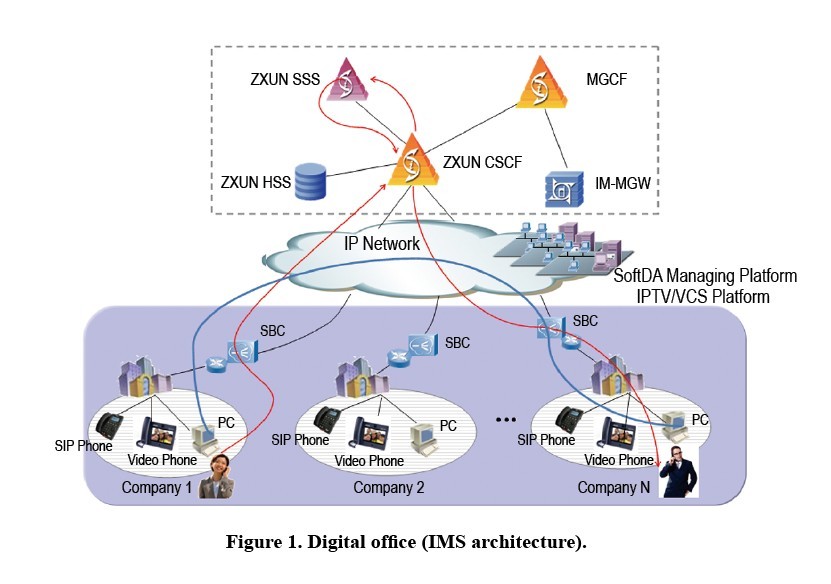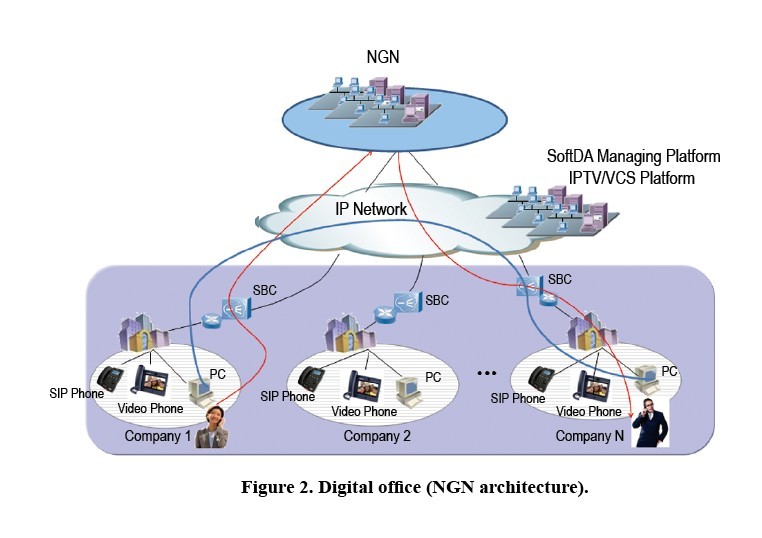Digital Office Creating a Digital World
Digital office applications include digital printing, PCs, digital telephones, video communication, email, IM-based work discussions, and file transfer. Through the IP network, office devices are connected to create a digital world. Digital office is centered on the IP network and integrates digital office facilities, communications, and remote access to create an integrated digital office environment. It facilitates communications and office work of enterprises and governments.
Telecom operators often rent their digital office systems to medium- or small-sized governments and enterprises. Large-sized governments and enterprises, especially transnational companies, build large digital office systems by themselves.
AT&T is the world’s largest telecom operator and has rolled four digital office solutions for enterprises and governments:
● For enterprises with less than 100 employees, AT&T offers the best long-distance, high-speed Internet, phone, data, and bundled services to help these businesses grow.
● For enterprises with more than 100 employees, AT&T offers network services as a foundation for applications. They offer efficiencies through cloud, content delivery, application and mobility services, and collaboration through unified communications.
● For buyers of wholesale services, AT&T offers reliable and highly secure end-to-end networks as well as IP and cloud-based services globally to meet the needs of wholesale customers.
● For government agencies, AT&T offers networking, mobility, unified communications, and cloud and managed IT solutions that are customized for federal, state and local government agencies.
Turk Telekom (TT), India Reliance, and China Mobile have also come up with their digital office solutions. These solutions create efficient, convenient and comfortable office environments for enterprises and governments, and bring a myriad of business opportunities to operators.
ZTE’s digital office solution aims to drive technological advancement and improve enterprise efficiency. It includes SIP phone (IP phone), video phone, PC, wireless handset and set top box (STB) at the terminal side, and NGN/IMS and SoftDA management platform at the infrastructure side. An IPTV platform and a video conferencing platform can be added to deliver multimedia information and office meeting services. Conference centers are provided for enterprises and governments, and multimedia information and entertainment services are provided for employees.
ZTE’s digital office solution allows office work to be better integrated. It delivers fast and convenient applications to enterprises. The digital office solution contains three functional modules: communication module, conference module and multimedia module.
Communication Module
The solution provides three service packages: ordinary office service, mid-level manager office services, and executive office service. It can satisfy user needs at different levels.


Ordinary office service
Staff use a PC configured with IM software, a SIP telephone, and a P801K UW101 (a USB base and a wireless handset) for conference calls. They can also chat, share files and desktop (electronic whiteboard), and transfer files.
● Scenario 1: A staff member communicates with another person over SIP under an IMS/NGN network. The communication can be made between PCs, between a PC and an IP phone, or between a PC and a mobile phone. The staff member can also make a conference call using IM. When making or receiving the call with a P801K UW101, the staff member can move freely within 50 meters without adversely affecting voice quality.
● Scenario 2: Internal staff members chat with each other or with external staff via IM. The communication is fast, free, and helps reduce office costs.
● Scenario 3: A staff member transfers large files to staff in other department via IM. The transfer is fast and alleviates the traffic burden on the mail server.
● Scenario 4: A hardware or software developer works efficiently through file and desktop sharing.
Mid-level manager office service
A mid-level manager uses an IP phone and an IM-enabled PC to hold an office conference using the IMS/NGN network. Communication can occur either between IP phones, between IP phones and PCs, or between IP phones and mobile phones. A multiparty meeting can be held using IM, or a party can attend the meeting using an IP phone. Through IM, the manager can also chat, share files and desktop (electronic whiteboard), and transfer files.
● Scenario 1: multiple numbers
People in an office share one P801 handset, each having a separate phone number. Alternatively, each person has a P801, and phone numbers are divided into work numbers and non-work numbers. Each person uses their phone number to make an outgoing call. A total of six incoming calls can be received.
● Scenario 2: call mute function
Several people may use one P801 to access a conference. However, they may wish to have private discussions and not be heard by participants in other locations. The P801 users can press the “mute” button without actually muting the P801 speaker to other P801 users. Everyone in front of P801 can hear the speaker, but their internal discussions cannot be heard by participants in other locations.
● Scenario 3: multiparty conference
P801 is used to make a local conference call through the network. A manager initiates a conference via IM to discuss sales. The manager can answer a call using an IP phone or a USB handset. The USB handset allows the manager to walk freely around the office while talking during the meeting.
Executive office service
A high-level executive uses a video phone, an IM-enabled PC, and a P801K UW101 to hold a video conference. If necessary, an IPTV STB can be configured in the office to deliver advertisements and IPTV services. The executive can also chat, share files and desktop (electronic whiteboard), and transfer files through IM (SoftDA).
● Scenario 1: point-to-point video call
A V510 video phone is used to call another V510 directly via an IP address or an IMS/NGN network. V510 faithfully re-creates the original sound with its robust microphones and speaker and accentuates the human voice through software adjustment to make the voice clearer.
● Scenario 2: three-party conference
A V510 is used to dial video phone numbers of second and third parties via an IMS system. Voices from the three parties can be mixed locally to implement third-party conference.
● Scenario 3: photo, video, and audio play
V510 can play photos, videos, and audio in an SD card.
● Scenario 4: attending a video conference
V510 can act as a video conference terminal to access a video conference system.
● Scenario 5: communication and data application synchronization
An executive can initiate a meeting with mid-level managers using a PC configured with IM software and a P801K UW101. The executive can move freely within 50 meters while receiving the conference call. The executive can also share files and content, send texts, and transfer files through PC with other participants during the conference.
Conference Module
A video conference system can be built to meet conference needs of transnational enterprises and government agencies at all levels.
● Application scenario: A video conference system is built to serve a group or a transnational group. Regular or irregular meetings can be held to discuss marketing strategies and project management.
Multimedia Module
In meeting rooms or along corridors, IPTV STBs can be deployed to push advertisements or deliver value-added services such as live IPTV, VOD, interactive games, and news.
● Application scenario: Employees can browse news, weather, culture, travel, cinema, and TV in the meeting rooms or along corridors in their leisure time.
Digital technologies propel us to create a highly efficient digital world.